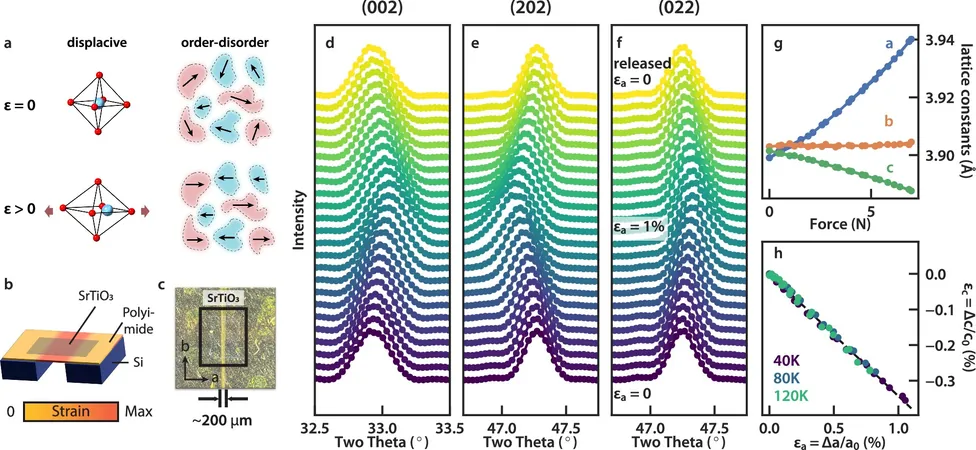
Strontium Titanate Breakthrough: A Stretch into Quantum Ferroelectricity!
2025-05-29
Author: Mei
From Jewelry to Quantum Innovation
Once a glittering substitute for diamonds, strontium titanate has resurfaced in groundbreaking research that explores its unique quantum properties. As scientists delve into this versatile material, they unlock potential applications in the realms of quantum computing and microelectronics.
The Game-Changing Ferroelectric State
Published in the prestigious journal Nature Communications, a team of researchers has revealed a dramatic transformation achieved by creating an ultra-thin, flexible membrane of strontium titanate. By applying strain, they switched the material into a ferroelectric state—akin to how permanent magnets generate their own magnetic fields, this new state produces its own electric field.
Wei-Sheng Lee, a lead scientist at SLAC National Accelerator Laboratory, expressed excitement about this discovery: "We can now reversibly and repeatedly toggle between ferroelectric and non-ferroelectric states, offering unprecedented insight into this transition in strontium titanate."
Unlocking the Secrets of Quantum Materials
Strain alters atomic distances within strontium titanate, affecting its electrical properties. This specific manipulation separates negatively charged oxygen and positively charged titanium ions, resulting in a functional electric field. The ability to induce ferroelectricity—and even superconductivity through the addition of impurities—positions strontium titanate at the forefront of next-gen computing and superconducting device technology.
Innovative Techniques Overcome Limitations
However, previous studies faced a hurdle: strontium titanate was notoriously brittle at room temperature, limiting how much it could be stretched before breaking. Thanks to innovative methods developed by Harold Hwang at Stanford, researchers produced incredibly thin and flexible membranes that could be manipulated without damage.
This breakthrough enabled the team, including Yonghun Lee and Jiarui Li, to attach the membranes to flexible plastic sheets. Using advanced X-ray techniques at the Advanced Photon Source (APS), they meticulously measured the material's electronic structure during stretching.
A Leap into Quantum Territory
As temperatures approached room temperature, the transition to a ferroelectric state demonstrated classical thermal fluctuations. However, when cooled to cryogenic temperatures, these fluctuations faded away, signaling a shift into the mysterious realm of quantum mechanics. This quantum crossover could explain why strontium titanate doesn’t naturally reach a ferroelectric state at these low temperatures without stretching.
At the quantum level, erratic fluctuations disrupt traditional order. By stretching the material, these quantum disturbances were suppressed, enabling the ferroelectric order to emerge, albeit in a manner distinct from classical transitions.
New Frontiers in Quantum Research
Jiarui Li highlighted the significance of their findings: "Our results suggest that quantum fluctuations play a pivotal role at lower temperatures, overshadowing classical effects during this transition." This discovery paves the way for further exploration into quantum materials, potentially revolutionizing technology as we know it.



 Brasil (PT)
Brasil (PT)
 Canada (EN)
Canada (EN)
 Chile (ES)
Chile (ES)
 Česko (CS)
Česko (CS)
 대한민국 (KO)
대한민국 (KO)
 España (ES)
España (ES)
 France (FR)
France (FR)
 Hong Kong (EN)
Hong Kong (EN)
 Italia (IT)
Italia (IT)
 日本 (JA)
日本 (JA)
 Magyarország (HU)
Magyarország (HU)
 Norge (NO)
Norge (NO)
 Polska (PL)
Polska (PL)
 Schweiz (DE)
Schweiz (DE)
 Singapore (EN)
Singapore (EN)
 Sverige (SV)
Sverige (SV)
 Suomi (FI)
Suomi (FI)
 Türkiye (TR)
Türkiye (TR)
 الإمارات العربية المتحدة (AR)
الإمارات العربية المتحدة (AR)